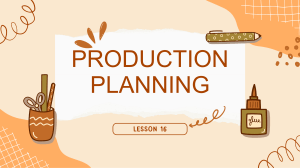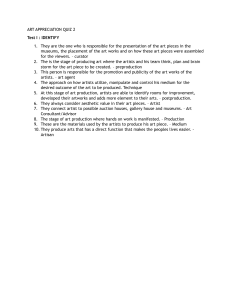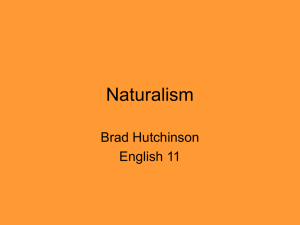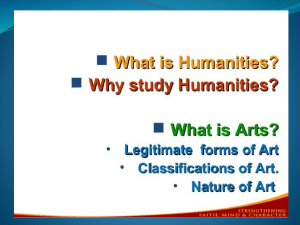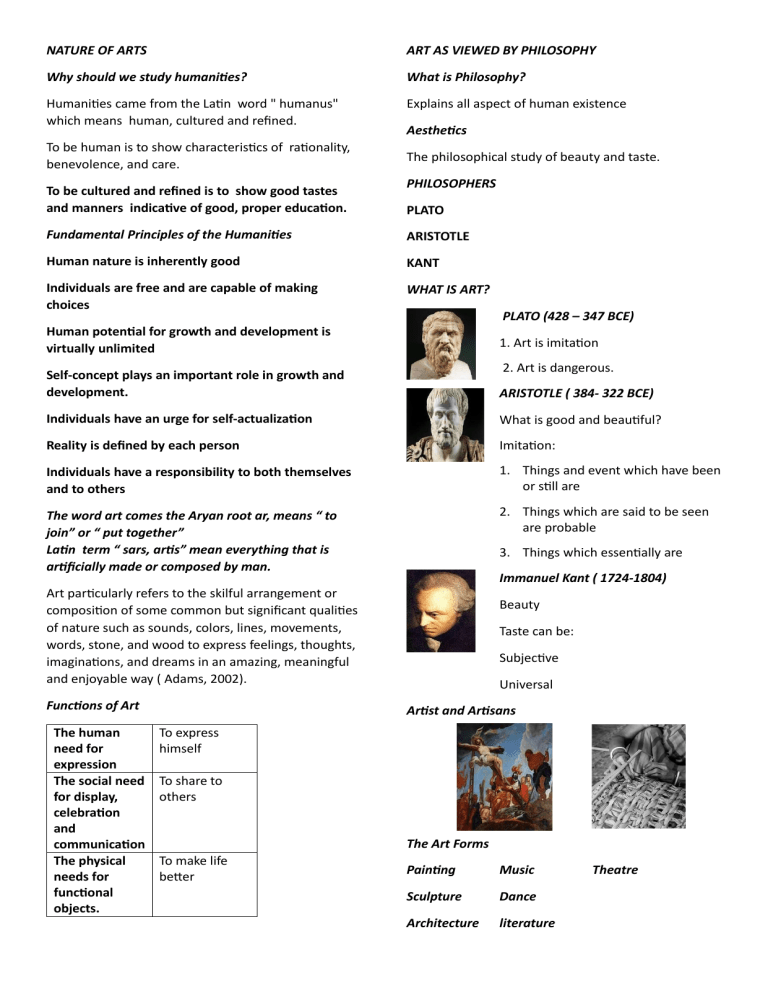
NATURE OF ARTS ART AS VIEWED BY PHILOSOPHY Why should we study humanities? What is Philosophy? Humanities came from the Latin word " humanus" which means human, cultured and refined. Explains all aspect of human existence To be human is to show characteristics of rationality, benevolence, and care. To be cultured and refined is to show good tastes and manners indicative of good, proper education. Aesthetics The philosophical study of beauty and taste. PHILOSOPHERS PLATO Fundamental Principles of the Humanities ARISTOTLE Human nature is inherently good KANT Individuals are free and are capable of making choices WHAT IS ART? PLATO (428 – 347 BCE) Human potential for growth and development is virtually unlimited 1. Art is imitation 2. Art is dangerous. Self-concept plays an important role in growth and development. ARISTOTLE ( 384- 322 BCE) Individuals have an urge for self-actualization What is good and beautiful? Reality is defined by each person Imitation: Individuals have a responsibility to both themselves and to others 1. Things and event which have been or still are The word art comes the Aryan root ar, means “ to join” or “ put together” Latin term “ sars, artis” mean everything that is artificially made or composed by man. 2. Things which are said to be seen are probable 3. Things which essentially are Immanuel Kant ( 1724-1804) Art particularly refers to the skilful arrangement or composition of some common but significant qualities of nature such as sounds, colors, lines, movements, words, stone, and wood to express feelings, thoughts, imaginations, and dreams in an amazing, meaningful and enjoyable way ( Adams, 2002). Functions of Art The human need for expression The social need for display, celebration and communication The physical needs for functional objects. Beauty Taste can be: Subjective Universal Artist and Artisans To express himself To share to others The Art Forms To make life better Painting Music Sculpture Dance Architecture literature Theatre PART 2 ❖ MYTHOLOGY SUBJECT AND CONTENT Art Subject Defined Subject ⮚ Refers to what the work represents ❖ DREAMS AND FANTASY ⮚ It could be a person, an object, a scene or an event. ⮚ Some artworks have subject and others do not Representational or Objective Arts ❖ TECHNOLOGY ⮚ The artworks that have subjects Non- representational or Non- objective Arts ⮚ Do not have subjects Source of Subject ⮚ Art is human expression and the artists’ choice of subject are clues to their inner world which tells viewers how their art should be interpreted. Ways of Presenting the Subject Naturalism • In Greek (Hellenistic) art, gods and heroes, looked and behaved like human beings. Greek deities were almost always depicted in idealized human form. In other words, one would immediately recognize that these images were imitated from the human figure. • In fine art panting, "naturalism" describes a true-to-life style which involves the representation or depiction of nature (including people) with the least possible distortion or interpretation. There is a quasiphotographic quality to the best naturalistic paintings: a quality which requires a minimum amount of visual detail. The ff. are the source of artists’ inspiration for their works: ❖ NATURE ❖ PEOPLE ❖ HISTORY Venus De Milo Ignudi detail from the Sistine Chapel Ceiling ❖ LEGENDS Realism • This depicts the artist’s attempt of portraying the subject as it is. • Naturalism is often confused with "realism", a true-life style of art which focuses on social realities and observable facts, rather than the ideals and aesthetics. b. Elongation Potato Eaters by Vincent Van Gogh ` - the subject is stretched vertically and/ or some parts lengthened to give the impression of thinnes. The Gleaners The Stone Breakers c. Mangling Naturalism vs Realism - This may not be common in paintings but may be popular in other art forms (sculpture, theatre and film). - Artists show subject as cut, lacerated, mutilated or hacked with repeated blows. Abstraction • Abstract means “to move away or to separate from”. • moves away from reality • Abstract art is art that does not attempt to represent an accurate depiction of a visual reality but instead use shapes, colours, forms and gestural marks to achieve its effect d. Cubism - use of figures: cone, cylinder, sphere, square, cube, circle in place of real pictorial elements Symbolism • A symbol is defined as visible sign of something invisible such as an idea or quality. • A message the artist may be trying to convey aside from what is obviously observed. • This adds a mysterious quality to the artwork that invites viewers to uncover. Very Embarrassing Father and Son a. Distortion - form of abstraction results when the figures have been so arranged that its proportion differ significantly from reality. - the subject is misshapen or twisted out. • This style of art depicts the emotions aroused by objects and events • Subjects presented involve chaos, sadness, tragedy and defeat. Mona Lisa (LDV) The “Creation of Adam” segment on the Sistine Chapel ceiling (Michelangelo) Fauvism • Literally means “wild beasts” • The fauves did not express ethical, philosophical or psychological themes but painted pictures of comfort, joy and pleasure. • Use bright colors Futurism • Artists of this movement wanted their work to capture the speed and force of the modern industrial society. • Highlight the technologies of modern life Surrealism • It emphasized the activities of subconscious mind. • Attempt to show man’s inner mind and how he may perceive his outside world. • Deep, true and ugly part of human nature Expressionism • Expressionists believe that man needs spiritual rebirth for him to correct defects that ruin the society.
